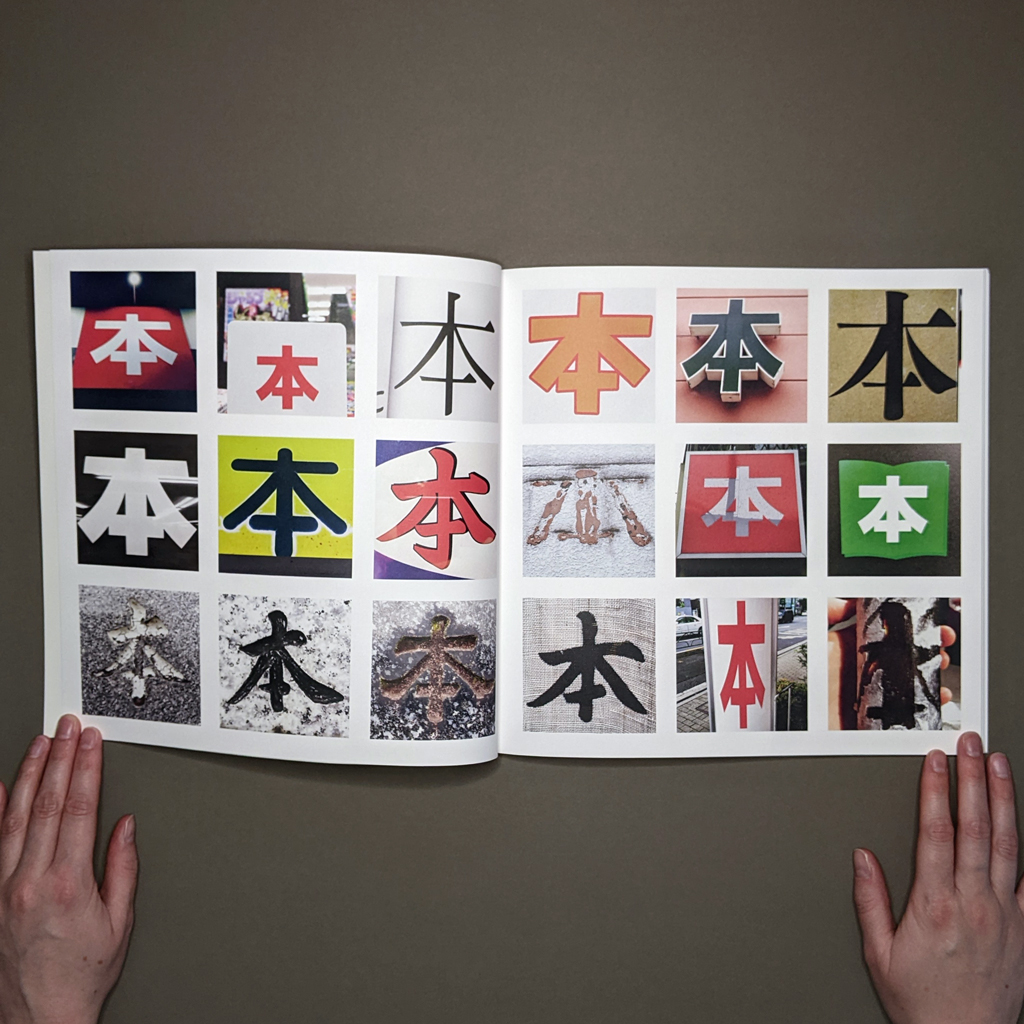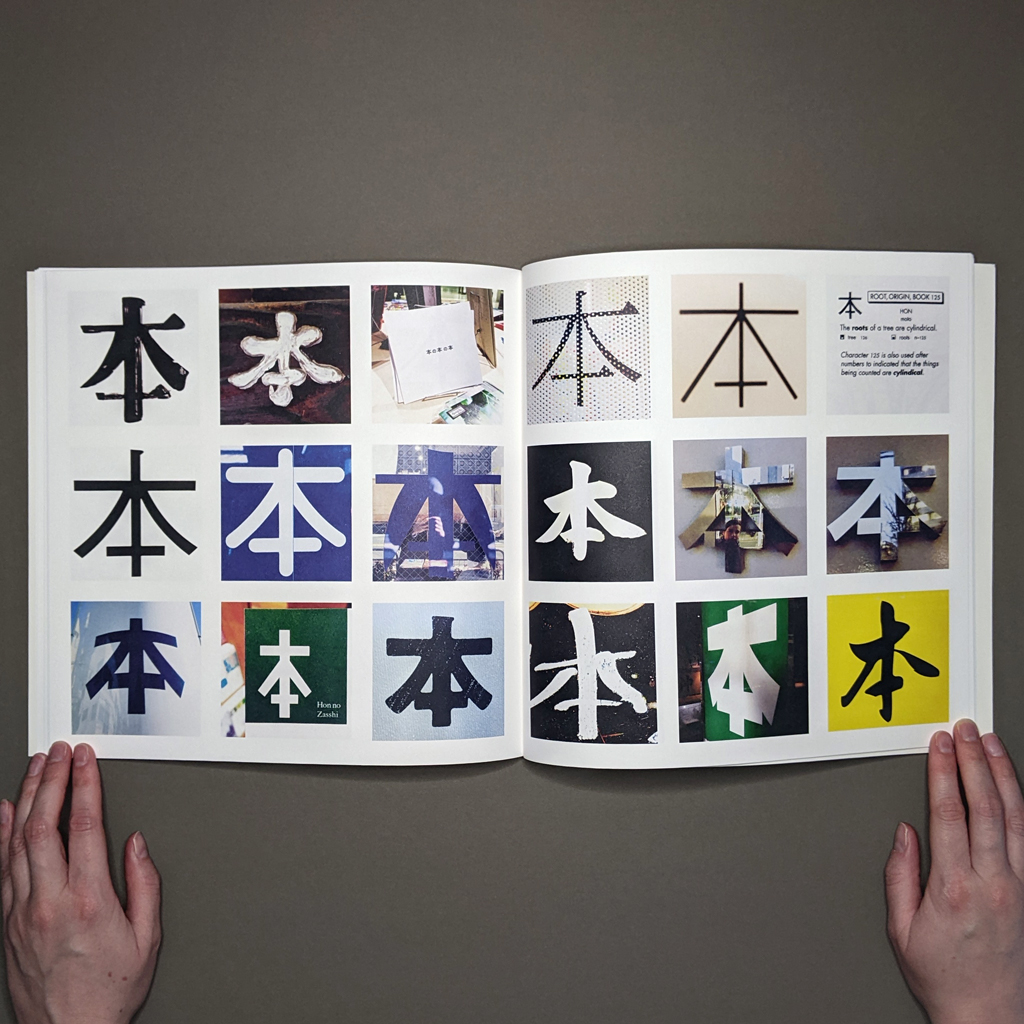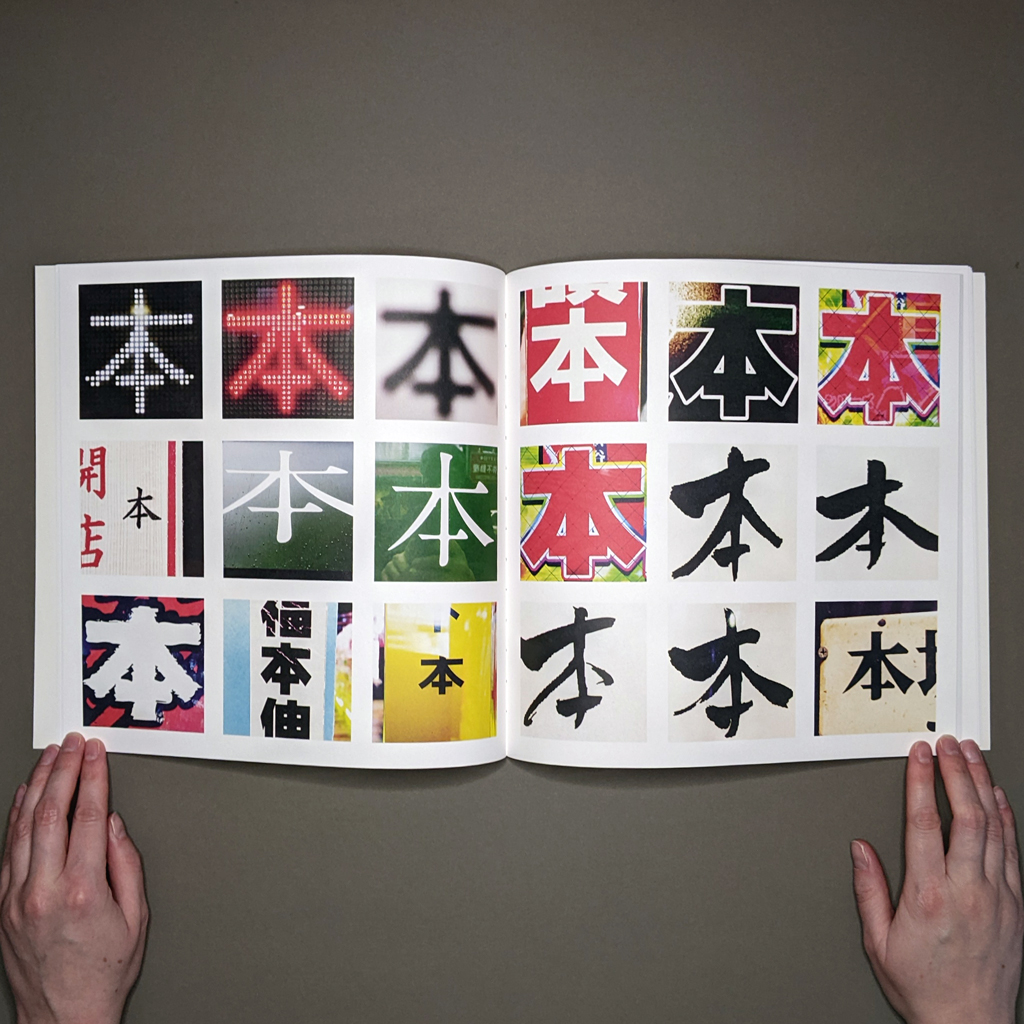Antoine Lefebvre
本の本の本
2021
Antoine Lefebvre Editions
21 × 10.5 in. open
48 pages
Perfect-bound softcover
Offset printing

“The idea becomes a machine that makes the art.”
Sol LeWitt, “Paragraphs on Conceptual Art,” Art Forum, 1967.
本の本の本 is a conceptual photographic artists’ book stemming from Antoine Lefebvre’s travels to Japan. Each duplex-printed page in the perfect-bound paperback has nine square photographs of the character 本 arranged in a 3 × 3 grid, forming spreads of eighteen images. The sheer variety of snapshots and their context — the materials and spaces where the character 本 appear — slows the reader, who must adjust to each ideogram’s weight, texture, and design. The character 本 is the lens Lefebvre provides the audience to view the idea of a book (which is one meaning of 本). Lefebvre’s thoughtfully crafted experience conveys to the reader that their mentally conceived book may be closer to its material counterpart than initially imagined.

Across a range of media, Lefebvre’s artistic practice constitutes research into our physical relationship with geography. For 本の本の本, Lefebvre’s photographic research began during his initial 2016 residency at the Palais des Paris in Takasaki, Japan. The first one hundred photographs come from this initial work and were first published in a small brochure upon Lefebvre’s return to Paris, while the later series of photographs are from his return to Japan in 2019.
Lefebvre’s photographs are as much about the ideogram and the unseen environment just outside the digital border as they are about their actual content. Their arrangement in a grid is inspired by Sol LeWitt’s Photogrids, who presented the grid’s ubiquity in unexpected contexts. The grid binds Lefebvre’s photographs together but also designates a space for each photograph, like the plots of urban space physically inhabited by the signs and objects Lefebvre has photographed. The quilt-like pattern of each page demonstrates Lefebvre’s skillful layout design, and the multiple, modular use of the 本form makes its perception and reception immediately available to the reader.

The viewer is aware that each 本 is unique in its color, surface, texture, and materiality; however, the photographs’ uniform, square format eliminates the reader’s sense of each character’s scale. As conceptual art, the photographs are meant to engage with the reader’s thoughts on what a book is as much as appeal to their emotional or visual enjoyment of the photographs. The work’s meaning is found in this conversation between artist, audience, and artwork.
Meaning — and language — are also deeply rooted in culture, and the project statement included in the book does provide helpful context on the multiple meanings of Japanese characters, Kanji, for those who may not be familiar with the language. I have practiced Japanese for a decade, and though I do not claim native proficiency with Japanese, this exposure offers insights into the linguistic and cultural nuances of the characters. By itself, the character 本 means “book,” but it holds numerous additional readings when associated with other Kanji. The interpretation of characters is derived from the context of the sentence. The book’s title playfully engages with this multiplicity of meaning, lightheartedly obfuscating interpretations, and pitting nuance against precise lexical meaning. Read as “Hon no hon no hon,” the title could be translated as “Books of books of books.” However, when we consider one of the alternative interpretations of 本 as the “origin,” the title becomes “The origin of the book of books,” or more concisely, “Origin of books book.” (Admittedly, considering the context, reading the title in any other way aside from “books of books of books” would be an imaginative stretch.)

Inside the book, I do worry that Lefebvre’s cropping of the images to focus on 本 may force the artist’s view onto the reader. By cropping the character out of its larger environment, Lefebvre can change the character 本 to mean “book” when originally it did not. For example, one images pairs 日 with本 to form the word for Japan, while in another the character appears on the side of a drink can. However, Lefebvre’s photographs are not intended as a fixed catalog of the character 本. The book’s images and ideas remain susceptible to temporal evolution, mirroring the dynamic interplay between the audience’s interpretation and Lefebvre’s own developing comprehension of his research method. Throughout the book, Lefebvre offers momentary peaks into his process via handwritten notes and photographs of earlier exhibitions.

Lefebvre’s repetitive photographic works diverge from iconography’s conventional commitment to signification. Meaning is simultaneously distinctly multiple and conspicuously absent. Certain depictions of the character 本, especially those characterized by bold geometric forms, assertive graphics, or vibrant colors, invite interpretation through their immediate and visceral impact. Conversely, images that are visually and conceptually more opaque pose greater challenges for viewers to seamlessly correlate geographical space with personal conceptualizations of what constitutes “book.” In these moments, the artist steps back and the reader can wander through these pictorial spaces guided by their interests. Each viewer’s introspection is built from a lifetime of interacting with books, with each viewpoint and inquiry as unique as Lefebvre’s many photographs of 本.
My initial reading of the book was emotionally dry, interested more in the spectacle of each photograph’s logical execution than in uncovering a more subjective meaning just beneath the surface. Over subsequent readings, I considered how Lefebvre’s project readily shifts the audience between reading text and viewing image. Likewise, the book foregrounds two modes of inscription: writing and photography. Then I found myself looking at my bookshelves several times, considering the types of books I have collected, their textures, and how they are a curated library of my personality and current interests.
本の本の本 encourages the reader to consider the cultural complexities of the book — an embodiment of power dynamics, societal structures, and ideological conflicts — through the lens of the character 本. Its exploration of language, culture, and the nuanced meanings of Kanji adds depth to the interplay of text and image, making it a thought-provoking contribution to contemporary artists’ books and Conceptual art. 本の本の本 carries forward the spirit of Conceptual art as an origin in its own right, questioning the essence of the book and offering a profound reevaluation of the familiar.

Leave a comment